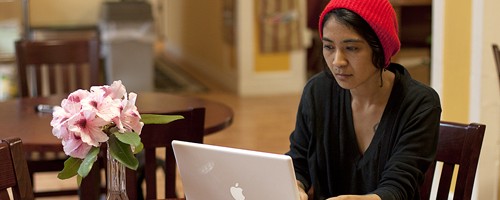Archeologists dig on campus
Archeologists got a look into the past recently with findings of artifacts dug up here on campus. Beginning stages of construction on the Native American Cultural Center included searching for possible traces of previously held residence in that location, which is between the tennis courts and the I-405 freeway. Workers were not disappointed when, within the first two scoops, they found evidence of human activity from the past.
Diggers began searching for artifacts the first weekend of October. What they first exposed was a 3.5 foot wide brick shaft that measured at least 14 feet deep, which was an encouraging sign to participants in the dig project that included students from Portland State’s Anthropology 350 class. Dirt was then removed in a simple excavation strategy called “arbitrary level excavation,” which involves taking scoops in 10cm increments and evaluating each clump of earth.
As this process was executed more and more was revealed that validated archeologist’s early predictions that such would be found. Those assumptions were made during the preliminary planning stages of the project when old Sanborn maps were reviewed by lead architect Burt Ewart and employees of Applied Archeological Research, which is the archeological firm heading up the project.
������
They were demolished when I-405 was built. Seeing that a home existed at the location is what prompted the archeological efforts.
Census records, which began recording addresses in 1900, showed the address of this particular building as being 467 S.W. Seventh Street, which is now S.W. Broadway. Researchers reviewed old tax records in hopes of finding the residents of the home, and the name Justus Strowbridge came up as the owner of the property.
Strowbridge was apparently a wealthy and prominent man who lived in Portland off and on between 1850 and 1890. Archeologists at the site speculate that in 1891 he purchased the property and lived there with his family until the early 1900s.
He was listed in records as a capitalist, meaning that he was most likely an investor who did not have to work for a living, and he owned several properties around the city. What archeologists were not able to learn from records is who else may have lived in the house, since only the owner’s name was listed. This question further aroused curiosity among the scientists who are hoping to get a more detailed look at life in Portland during that time.
It was determined a family must have lived there when unopened jars of what appeared to be baby food were found. Also among the artifacts, found in an old well and septic tank hole, were old beer and whiskey bottles, marbles, buttons, square nails, plates and baby bottles shaped like pumpkin seeds, which can be seen in Sears Roebuck catalogs from the 1890s. The well and outhouse were most likely replaced in the 1890s by plumbing and running water, when those utilities were installed around Portland.
Julie Shablitsky, a recent graduate of Portland State University’s doctoral program in archeology and employee with Applied Archeological Research, was very excited about these findings.
“They really help paint a picture of not just who was living there at that time but, more importantly, what types of lifestyles they had,” Shablitsky said. “We are also trying to get a look at how Portland developed as a city.”
Shablitsky also noted how important it was that students were able to get involved, adding “The city really is a classroom and this is a prime example.”
Participating in the dig project was Bridget Antel, a senior at Portland State majoring in history with a minor in anthropology. Her anthropology class, taught by Virginia Butler, was offered the opportunity to take part in what turned out to be an excellent hands-on experience for those interested in archeology.
Students learned how to screen clumps of dirt for artifacts, how to properly dig and how work is generally done in the field. This opportunity cemented Antel’s choice to go into archeology when she realized that she could handle the physical aspect of the work.
“It was great to be part of a real project, especially since it was right in our own backyard,” Antel said. “The first hand experience opens up a whole new world.”
Further opportunities will be available for students interested in hands-on experience in archeological work, according to Butler.
Each summer there is a field school offered through the anthropology department, and this past summer’s work was done at Ft. Vancouver, Wash., where students helped with excavation inside the fort and at the Kanaka Village. Butler, who has been involved in excavation projects in Polynesia, India, and at other international sites, was excited about the locality of this project.
“What made this project special is that it was right here on campus, and it helps us learn about our ancestors,” Butler said. “The physical remains tell us what isn’t written down in records, the things about their lifestyles.”
One ancestor in particular that was linked to Justus Strowbridge is his brother Joseph, who has descendants currently living in Molalla, Ore. Members of Applied Archeological Research are asking to be contacted at 503-281-9451 by anyone who has further information of links to the Strowbridge family.




